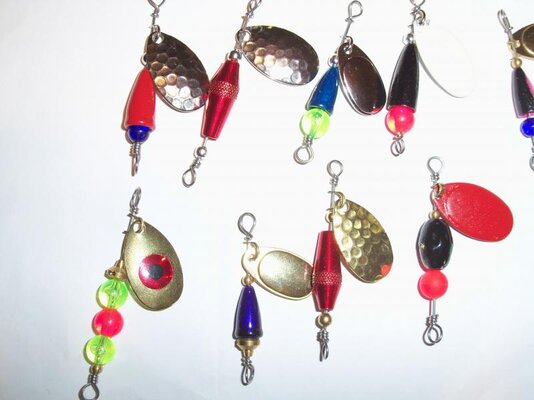Hi all - Newbie to your forum here, greetings from Southern Oregon. I have been reading this thread with interest because I have also been infected with the spinner-making bug. Lots of good info here from folks with experience, it's great that they are willing to share some of their wisdom. I started making and fishing spinners one year ago and it has been rewarding and productive, but I still have a lot to learn.
Fishfinger - You made mention of blade cavitation. That is a new term to me regarding spinner blades, what causes it, and is it a good thing or a bad thing?
ModestMan – We make some identical spinners, Black & Silver for steel and salmon, blue & silver for steel. Lots of fish on these two patterns.
1nut – Those look like LPO bodies on your spinners, what weight are they and what size blade have you paired them with? I’ve only used the 3/8 oz and matched them with a #5 blade. Bodies aren't a super expensive component but still a significant portion of the cost of every spinner. I started out making bodies using two worm weights back-to-back. That makes a 1/4 ounce body that works well with #4 or #5 blades. I now use a walleye-type walking sinker mold to produce a variety of lead body weights from 1/8 ounce to 5/8 ounce. I have painted them various colors but mostly use black. Rattle can spray paint, fingernail polish, or powder coating all work for painting them. I can buy spinner bodies for 75 cents each, or for the same 75 cents I can pour 50 spinner bodies, and for a few evenings work I have several years worth of bodies poured and waiting for paint.
,
Interesting chart posted above that shows weight of spinner for specific blade sizes. The spinners I am making now are #5 and since they will be used for fall salmon some are significantly heavier than the .42 oz to .47 oz recommended in the chart. My standard weight is .55 oz and sometimes use .67 oz in order to get the lure down in the strike zone in the larger holes that have both current and depth. The blades start easily and spin reliably and most important, they catch fish. Jed Davis says in his book on spinner fishing that his finished #5's weigh slightly more than a half ounce, and that's pretty much what my standard #5 weighs.
Last year's salmon spinners were made with round bend treble hooks, based on Jed Davis' recommendation. I have since gone completely to siwash hooks, first I used Gami hooks but they are soft and bend easily, now I use Eagle Claw 210N hooks. These Eagle Claw hooks are poor at best out of the package but work well if you modify them by bending the point in and offsetting the point. They are somewhat brittle, so once the open eye is closed it is likely the eye will break if you try to open it back up. They have a nice long point and don't bend out on larger fish. I have heard good things about the Mustad 10848 but I have yet to actually see them. I'll probably give them a try if I can ever find some.
Much has been said here regarding spinner balance. I may be in a minority, but for my purposes, balance is the relationship between the size/weight of the body and the size/ weight of the blade. In other words a spinner is balanced if the blade begins rotating immediately after entering the water. I do not want my spinners to operate smoothly with no vibration, in fact I purposely destabilize it by making modifications to the blade. There is a noticeable wobble, maybe even a little kick from side to side, and they absolutely thump the rod tip. I believe that the extra motion and resulting vibration are fish attractors, and more importantly I am receiving real time data from my terminal gear, telling me what is going on down there in the strike zone. I do want my spinner wire straight, and I make a round loop at the bottom so the hook is centered, preventing the hook from doing a tail flop like a poorly rigged plug cut herring.
This brings me to a point I haven’t seen mentioned yet in this thread, and that is how to fish a spinner. The maxim for spinner fishing is low and slow, and if you can’t feel your blade spin you can’t manipulate it to do what you want. I have heard the analogy that you don’t cast and retrieve a spinner (or spoon), you operate it. You are at the controls, and you “drive” your spinner like a little car through the holding water by controlling the location in the hole, what part of the water column your car is driving through, and how fast it is travelling through that holding water. The easier it is for you to feel the blade rotation, the better control you have to put it where you want, at the speed you want. Being low puts it near the bottom, and slow means controlling the spinner for the slowest blade spin possible. You can also slow down the progress of the spinner as a whole by mending your line after the cast, just like you would fly fishing. Using braid for mainline helps because it floats, making line mending easy.
I like the idea of a forum for tackle making and will be keeping an eye out for more threads like this. I'm always open to suggestions and new ideas, lots of good ideas here. Looks like I may have a chance to do more "field testing" either tomorrow or the next day, it's a nasty job but somebody has to do it. (sigh)
rangr



